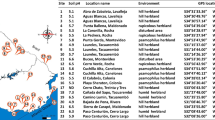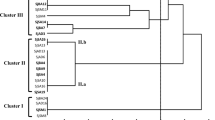Abstract
Pterocarpus officinalis Jacq. is a legume tree native to the Caribbean islands and South America growing as a dominant species in swamp forests. To analyze (i) the genetic diversity and (ii) the symbiotic properties of its associated nitrogen-fixing soil bacteria, root nodules were collected from P. officinalis distributed in 16 forest sites of the Caribbean islands and French Guiana. The sequencing of the 16S-23S ribosomal RNA intergenic spacer region (ITS) showed that all bacteria belonged to the Bradyrhizobium genus. Bacteria isolated from insular zones showed very close sequence homologies with Bradyrhizobium genospecies V belonging to the Bradyrhizobium japonicum super-clade. By contrast, bacteria isolated from continental region displayed a larger genetic diversity and belonged to B. elkanii super-clade. Two strains from Puerto Rico and one from French Guiana were not related to any known sequence and could be defined as a new genospecies. Inoculation experiments did not show any host specificity of the Bradyrhizobium strains tested in terms of infectivity. However, homologous Bradyrhizobium sp. strain-P. officinalis provenance associations were more efficient in terms of nodule production, N acquisition, and growth than heterologous ones. The dominant status of P. officinalis in the islands may explain the lower bacterial diversity compared to that found in the continent where P. officinalis is associated with other leguminous tree species. The specificity in efficiency found between Bradyrhizobium strains and host tree provenances could be due to a coevolution process between both partners and needs to be taken in consideration in the framework of rehabilitation plantation programs.

Similar content being viewed by others
References
Aguilar OM, Riva O, Peltzer E (2004) Analysis of Rhizobium etli and of its symbiosis with wild Phaseolus vulgaris supports coevolution in centers of host diversification. PNAS 101:13548–13553
Bâ AM, Samba R, Sylla S, Le Roux C, Neyra M, Rousteau A, Imbert D, Toribio A (2004) Caractérisation de la diversité des microorganismes symbiotiques de Pterocarpus officinalis dans des forêts marécageuses de Guadeloupe et Martinique. Rev Ecol 59:163–170
Bacon P (1990) Ecology and management swamp forest in the Guianas and Caribbean region. In: Lugo AE, Brinson M, Brown S (eds) Ecosystems of the World 15. Forested Wetlands, Elsevier, Amsterdam, pp 213–250
Bala A, Murphy P, Giller KE (2003) Distribution and diversity of rhizobia nodulating agroforestry legumes in soils from three continents. Mol Ecol 12:917–930
Barrios E, Herrera R (1994) Nitrogen cycling in Venezuelan tropical seasonally flooded forest: soil nitrogen mineralization and nitrification. J Trop Ecol 10:399–416
Bonhême I, Rousteau A, Imbert D, Saur E (1998) La forêt marécageuse à Pterocarpus officinalis : sa situation en Guadeloupe. Bois For Trop 258:59–68
Boukhatem ZF, Domergue O, Merabet C, Sekour S, Bouazza F, de Lajudie P, Duponnois R, Bekki A, Galiana A (2012) Symbiotic characterization and diversity of rhizobia associated with native and introduced Acacias in arid and semi-arid regions in Algeria. FEMS Microbiol Ecol 80:534–547
Cintrón BB (1983) Coastal freshwater swamp forests: Puerto Rico's most endangered ecosystem. In: Lugo AE (ed) Los bosques de Puerto Rico, Institute of Tropical Forestry, USDA 31. Forest Service, Rio Piedras, Puerto Rico, pp 249–282
de Faria S, Diedhiou AG, de Lima HC, Ribeiro RG, Galiana A, Alexandre F, Castilho AF, Henriques JC (2010) Evaluating the nodulation status of leguminous species from the Amazonian forest of Brazil. J Exp Bot 63:4191–4212
Diabate M, Munive A, de Faria SM, Bâ AM, Dreyfus B, Galiana A (2005) Occurrence of nodulation in unexplored leguminous trees native to the West African rain forest—application to rhizobial inoculation of native species. New Phytol 166:231–239
Diouf D, Fall D, Chaintreuil C, Bâ AT, Dreyfus B, Neyra M, Ndoye I, Moulin L (2009) Phylogenetic analyses of symbiotic genes and characterization of functional traits of Mesorhizobium spp. strains associated with the promiscuous species Acacia seyal Del. J Appl Microbiol 108:818–830
Dulormne M, Musseau O, Muller F, Bâ AM (2010) Effects of NaCl on growth, water status, N2 fixation, and ion distribution in Pterocarpus officinalis seedlings. Plant Soil 327:23–24
Fougnies L, Renciot S, Muller F, Plenchette C, Prin Y, de Faria SM, Bouvet JM, Sylla S, Dreyfus B, Bâ AM (2007) Arbuscular mycorrhizal colonization and nodulation improve flooding tolerance in Pterocarpus officinalis Jacq. seedlings. Mycorrhiza 17:159–166
Galiana A, Chaumont J, Diem HG, Dommergues YR (1990) Nitrogen-fixing potential of Acacia mangium and Acacia auriculiformis seedlings inoculated with Bradyrhizobium and Rhizobium spp. Biol Fertil Soils 9:261–267
Gascuel O (1997) BIONJ: an improved version of the NJ algorithm based on a simple model of sequence data. Mol Biol Evol 14:685–695
Gibson AH (1980) Methods for legumes in glasshouse and controlled environment cabinet. In: Bergersen FJ (ed) Methods for Evaluating Biological Nitrogen Fixation. Wiley-Interscience, Chichester, pp 139–184
Gomez A, Gonzales-Martinez SC, Collada C, Climent J, Gil L (2003) Complex population genetic structure in the endemic Canary Island pine revealed using chloroplast microsatellite markers. Theor Appl Genet 107:1123–1131
Gouy MS, Guindon S, Gascuel O (2010) SeaView version 4: a multiplatform graphical user interface for sequence alignment and phylogenetic tree building. Mol Biol Evol 27:221–224
Graham P (1992) Stress tolerance in Rhizobium and Bradyrhizobium, and nodulation under adverse soil conditions. Can J Microbiol 38:475–484
Koponen P, Nygren P, Domenach AM, Le Roux C, Saur E, Roggy JC (2003) Nodulation and dinitrogen fixation of legume trees in tropical freshwater swamp forest in French Guiana. J Trop Ecol 19:655–666
Lafay B, Burdon JJ (2001) Small-subunit rRNA genotyping of rhizobia nodulating Australian Acacia spp. Appl Environ Microbiol 67:396–402
Le Roux C, Tentchev D, Prin Y, Goh D, Japarudin Y, Perrineau MM, Duponnois R, Domergue O, de Lajudie P, Galiana A (2009) Bradyrhizobium nodulating the Acacia mangium x A. auriculiformis interspecific hybrid are specific and differ from those associated with both parental species. Appl Environ Microbiol 75:7752–7759
McKey D (1994) Legumes and nitrogen: the evolutionary ecology of nitrogen-demanding lifestyle. In: Sprent JL, McKey D (eds) Advances in Legume Systematics 5, The Nitrogen Factor. Royal Botanic Gardens, Kew, pp 211–229
Moreira FMS, Da Silva MF, de Faria SM (1992) Occurrence of nodulation in legume species in Amazon region of Brazil. New Phytol 121:563–570
Moreira FMS, Haukka K, Young JPW (1998) Biodiversity of rhizobia isolated from a wide range of forest legumes in Brazil. Mol Ecol 7:889–895
Muller F, Vaillant A, Bâ AM, Bouvet JM (2006) Isolation and characterization of microsatellite markers in Pterocarpus officinalis Jacq. Mol Ecol Notes 6:462–464
Muller F, Voccia M, Bâ AM, Bouvet JM (2009) Genetic diversity and gene flow in a Caribbean tree Pterocarpus officinalis Jacq.: a study based on chloroplast and nuclear microsatellites. Genetica 135:185–198
Parker MA (2003) Genetic markers for analysing symbiotic relationships and lateral gene transfer in Neotropical bradyrhizobia. Mol Ecol 12:2447–2455
Ponsonnet C, Nesme X (1994) Identification of Agrobacterium strains by PCR-RFLP analysis of pTi and chromosomal regions. Arch Microbiol 161:300–309
Rangin C, Brunel B, Cleyet-Marel JC, Perrineau MM, Béna G (2008) Effects of Medicago truncatula genetic diversity, rhizobial competition, and strain effectiveness on the diversity of a natural Sinorhizobium species community. Appl Environ Microbiol 74:5653–5661
Rasolomampianina R, Bailly X, Fetiarison R, Rabevohitra R, Béna G, Ramaroson L, Raherimandimby M, Moulin L, de Lajudie P, Dreyfus B, Avarre JC (2005) Nitrogen-fixing nodules from rose wood legume trees (Dalbergia spp.) endemic to Madagascar host seven different genera belonging to α- and β-Proteobacteria. Mol Ecol 14:4135–4146
Rivera-Ocasio E, Aide M, Rios-Lopez N (2007) The effects of salinity on the dynamics of a Pterocarpus officinalis forest stand in Puerto Rico. J Trop Ecol 23:559–568
Saint-Etienne L, Paul S, Imbert D, Dulormne M, Muller F, Torobio A, Plenchette C, Bâ AM (2006) Arbuscular mycorrhizal soil infectivity in a stand of the wetland tree Pterocarpus officinalis along a salinity gradient. For Ecol Manag 232:86–89
Saur E, Bonhême I, Nygren P, Imbert D (1998) Nodulation of Pterocarpus officinalis in the swamp forest of Guadeloupe (lesser Antilles). J Trop Ecol 14:761–770
Schloss PD, Westcott SL, Ryabin T, Hall JR, Hartmann M et al (2009) Introducing mothur: open-source platform-independent community-supported software for describing and comparing microbial communities. Appl Environ Microbiol 75:7537–7541
Sprent JI (1999) Nitrogen fixation and growth of non-crop legume species in diverse environments. Perspectives in plant ecology. Evol Syst 2:149–162
Vincent JM (1970) A manual for the Practical Study of the Root-Nodule Bacteria. Blackwell Scientific, Oxford
Vinuesa P, Rojas-Jiménez K, Contreras-Moreira B, Mahna SK, Prasad BN, Moe H, Selvaraju SB, Thierfelder H, Werner D (2008) Multilocus sequence analysis for assessment of the biogeography and evolutionary genetics of four Bradyrhizobium species that nodulate soybeans on the Asiatic continent. Appl Environ Microbiol 74:6987–6996
Wang ET, Martinez-Romero J, Martinez-Romero E (2002) Genetic diversity of rhizobia from Leucaena leucocephala nodules in Mexican soils. Mol Ecol 8:711–724
Willems A, Coopman R, Gillis M (2001) Comparison of sequence analysis of 16 s-23s rDNA spacer regions, AFLP analysis and DNA-DNA hybridizations in Bradyrhizobium. Int J Syst Evol Microbiol 51:623–632
Zak D, Holmes W, White D, Peacock AD, Tilman D (2003) Plant diversity, soil microbial communities, and ecosystem function: are there any link? Ecology 84:2042–2050
Zhang YM, Li Y, Chen WF, Wang ET, Tian CF, Li QQ, Zhang YZ, Sui XH, Chen WX (2011) Biodiversity and biogeography of rhizobia associated with soybean plants grown in the North China Plain. Appl Environ Microbiol 77:6331–6342
Acknowledgments
We would like to thank the French Ministry MEDD (Ministère de L’Ecologie et du Développement Durable) for the financial support to implement the Pterocarpus officinalis project. This work was financially supported by the Guadeloupe Archipelago Region and the Social European Fund. We are very grateful to colleagues from the University of Antilles-Guyane, especially A. Rousteau and A. Mitchell, as well as E. Rivera-Ocasio from the University of Puerto Rico, Río Piedras for his assistance in the collection of biological samples, and to A. Vaillant and M. Poitel from CIRAD for their technical assistance in the laboratory. We thank H. Sanguin from CIRAD for his assistance in the use of mothur software and L. Dedieu from Cirad for her careful and critical reading of our manuscript.
Author information
Authors and Affiliations
Corresponding author
Additional information
Christine Le Roux and Félix Muller contributed equally to this paper.
Rights and permissions
About this article
Cite this article
Le Roux, C., Muller, F., Bouvet, JM. et al. Genetic Diversity Patterns and Functional Traits of Bradyrhizobium Strains Associated with Pterocarpus officinalis Jacq. in Caribbean Islands and Amazonian Forest (French Guiana). Microb Ecol 68, 329–338 (2014). https://doi.org/10.1007/s00248-014-0392-7
Received:
Accepted:
Published:
Issue Date:
DOI: https://doi.org/10.1007/s00248-014-0392-7




